Audit And Ethics Behavior Assignment
VerifiedAdded on 2022/09/11
|13
|2957
|15
AI Summary
Contribute Materials
Your contribution can guide someone’s learning journey. Share your
documents today.
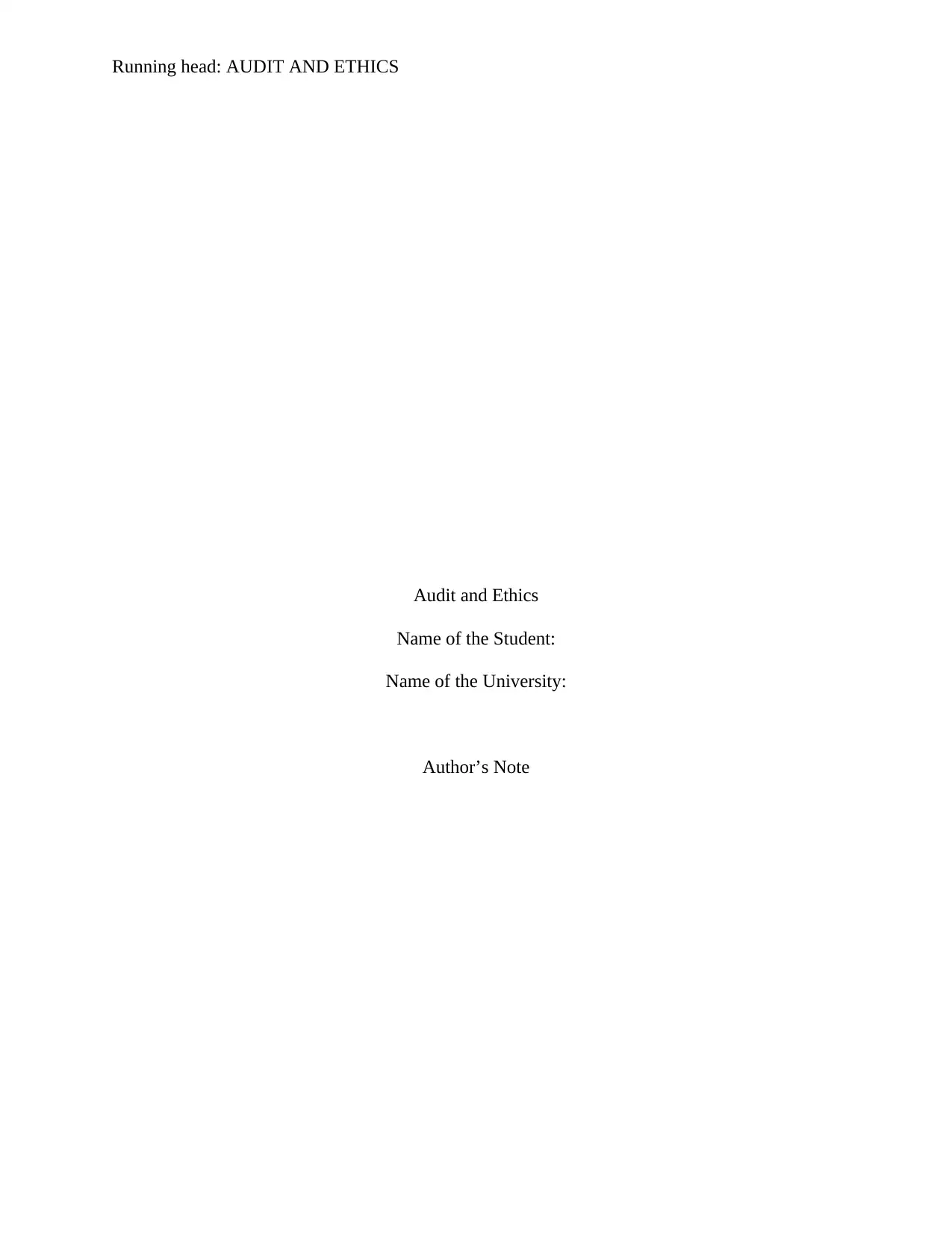
Running head: AUDIT AND ETHICS
Audit and Ethics
Name of the Student:
Name of the University:
Author’s Note
Audit and Ethics
Name of the Student:
Name of the University:
Author’s Note
Secure Best Marks with AI Grader
Need help grading? Try our AI Grader for instant feedback on your assignments.
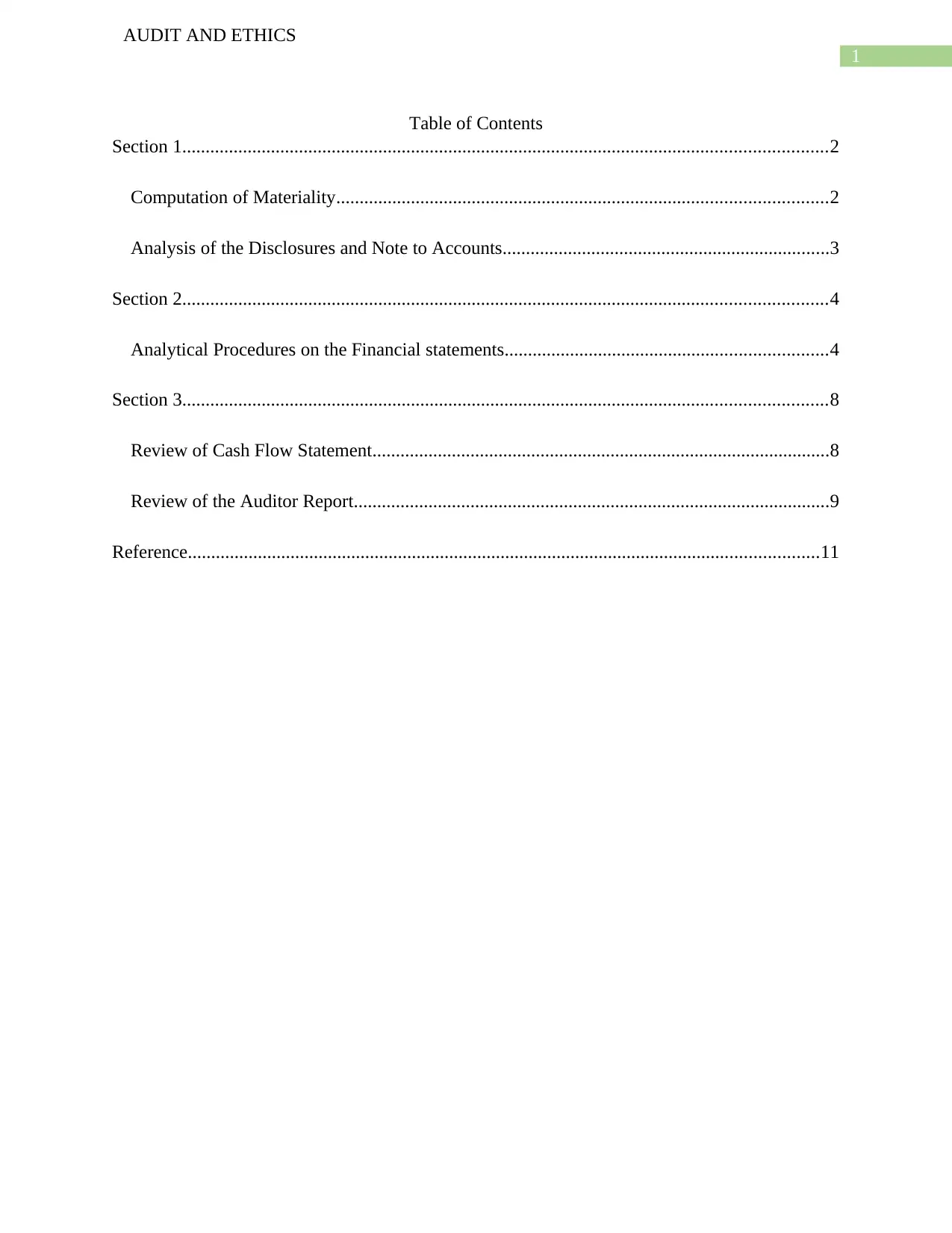
1
AUDIT AND ETHICS
Table of Contents
Section 1..........................................................................................................................................2
Computation of Materiality.........................................................................................................2
Analysis of the Disclosures and Note to Accounts......................................................................3
Section 2..........................................................................................................................................4
Analytical Procedures on the Financial statements.....................................................................4
Section 3..........................................................................................................................................8
Review of Cash Flow Statement..................................................................................................8
Review of the Auditor Report......................................................................................................9
Reference.......................................................................................................................................11
AUDIT AND ETHICS
Table of Contents
Section 1..........................................................................................................................................2
Computation of Materiality.........................................................................................................2
Analysis of the Disclosures and Note to Accounts......................................................................3
Section 2..........................................................................................................................................4
Analytical Procedures on the Financial statements.....................................................................4
Section 3..........................................................................................................................................8
Review of Cash Flow Statement..................................................................................................8
Review of the Auditor Report......................................................................................................9
Reference.......................................................................................................................................11
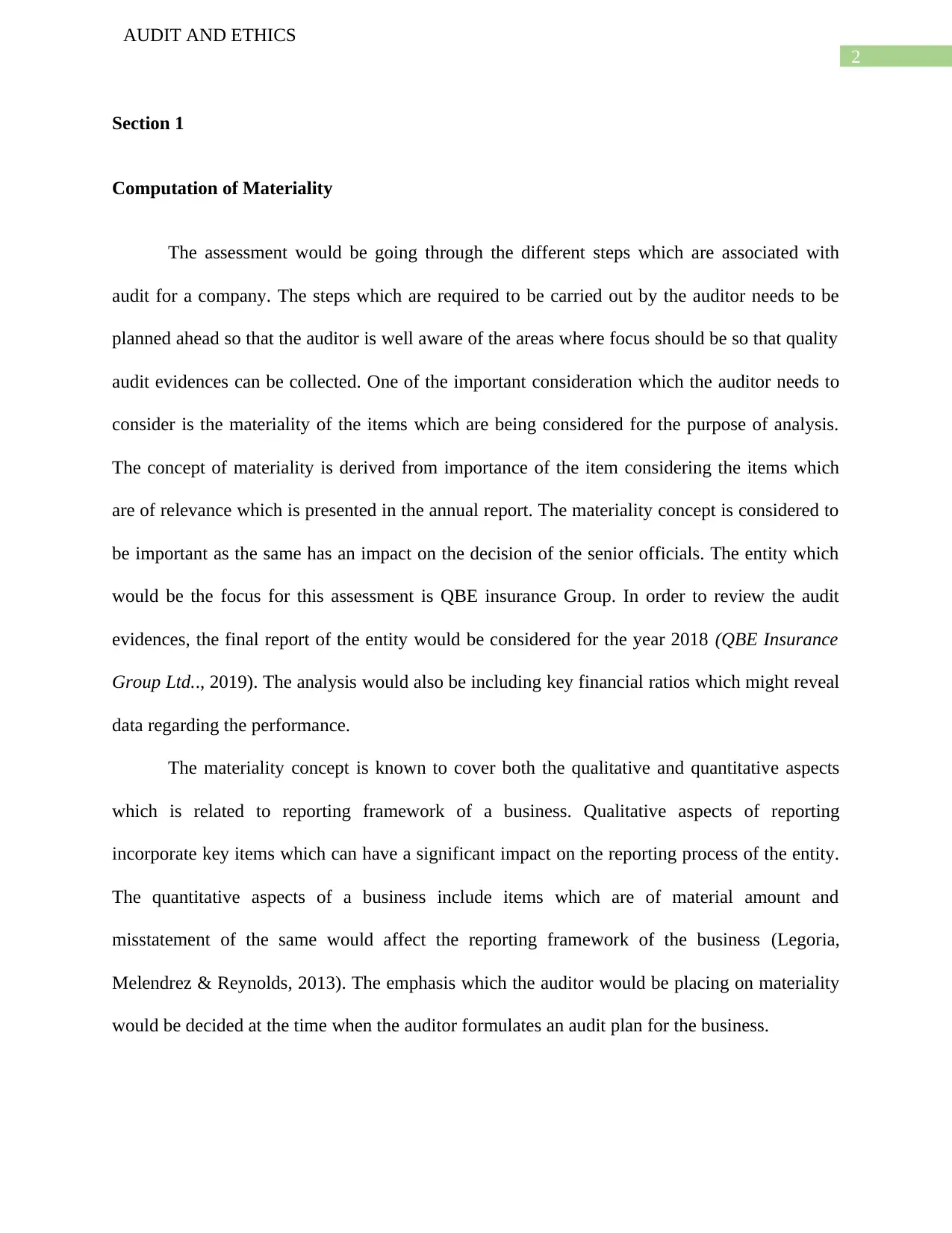
2
AUDIT AND ETHICS
Section 1
Computation of Materiality
The assessment would be going through the different steps which are associated with
audit for a company. The steps which are required to be carried out by the auditor needs to be
planned ahead so that the auditor is well aware of the areas where focus should be so that quality
audit evidences can be collected. One of the important consideration which the auditor needs to
consider is the materiality of the items which are being considered for the purpose of analysis.
The concept of materiality is derived from importance of the item considering the items which
are of relevance which is presented in the annual report. The materiality concept is considered to
be important as the same has an impact on the decision of the senior officials. The entity which
would be the focus for this assessment is QBE insurance Group. In order to review the audit
evidences, the final report of the entity would be considered for the year 2018 (QBE Insurance
Group Ltd.., 2019). The analysis would also be including key financial ratios which might reveal
data regarding the performance.
The materiality concept is known to cover both the qualitative and quantitative aspects
which is related to reporting framework of a business. Qualitative aspects of reporting
incorporate key items which can have a significant impact on the reporting process of the entity.
The quantitative aspects of a business include items which are of material amount and
misstatement of the same would affect the reporting framework of the business (Legoria,
Melendrez & Reynolds, 2013). The emphasis which the auditor would be placing on materiality
would be decided at the time when the auditor formulates an audit plan for the business.
AUDIT AND ETHICS
Section 1
Computation of Materiality
The assessment would be going through the different steps which are associated with
audit for a company. The steps which are required to be carried out by the auditor needs to be
planned ahead so that the auditor is well aware of the areas where focus should be so that quality
audit evidences can be collected. One of the important consideration which the auditor needs to
consider is the materiality of the items which are being considered for the purpose of analysis.
The concept of materiality is derived from importance of the item considering the items which
are of relevance which is presented in the annual report. The materiality concept is considered to
be important as the same has an impact on the decision of the senior officials. The entity which
would be the focus for this assessment is QBE insurance Group. In order to review the audit
evidences, the final report of the entity would be considered for the year 2018 (QBE Insurance
Group Ltd.., 2019). The analysis would also be including key financial ratios which might reveal
data regarding the performance.
The materiality concept is known to cover both the qualitative and quantitative aspects
which is related to reporting framework of a business. Qualitative aspects of reporting
incorporate key items which can have a significant impact on the reporting process of the entity.
The quantitative aspects of a business include items which are of material amount and
misstatement of the same would affect the reporting framework of the business (Legoria,
Melendrez & Reynolds, 2013). The emphasis which the auditor would be placing on materiality
would be decided at the time when the auditor formulates an audit plan for the business.
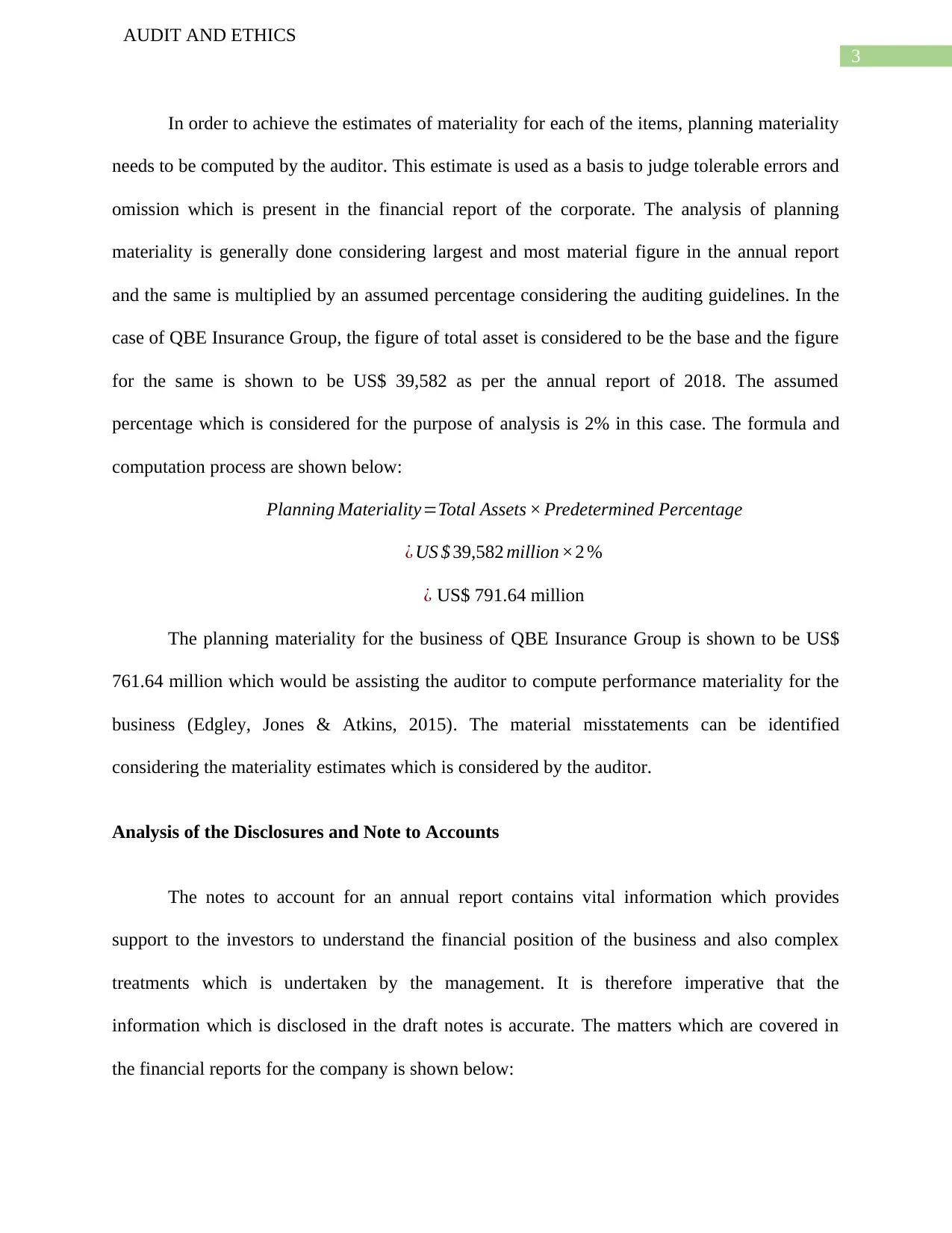
3
AUDIT AND ETHICS
In order to achieve the estimates of materiality for each of the items, planning materiality
needs to be computed by the auditor. This estimate is used as a basis to judge tolerable errors and
omission which is present in the financial report of the corporate. The analysis of planning
materiality is generally done considering largest and most material figure in the annual report
and the same is multiplied by an assumed percentage considering the auditing guidelines. In the
case of QBE Insurance Group, the figure of total asset is considered to be the base and the figure
for the same is shown to be US$ 39,582 as per the annual report of 2018. The assumed
percentage which is considered for the purpose of analysis is 2% in this case. The formula and
computation process are shown below:
Planning Materiality=Total Assets × Predetermined Percentage
¿ US $ 39,582 million ×2 %
¿ US$ 791.64 million
The planning materiality for the business of QBE Insurance Group is shown to be US$
761.64 million which would be assisting the auditor to compute performance materiality for the
business (Edgley, Jones & Atkins, 2015). The material misstatements can be identified
considering the materiality estimates which is considered by the auditor.
Analysis of the Disclosures and Note to Accounts
The notes to account for an annual report contains vital information which provides
support to the investors to understand the financial position of the business and also complex
treatments which is undertaken by the management. It is therefore imperative that the
information which is disclosed in the draft notes is accurate. The matters which are covered in
the financial reports for the company is shown below:
AUDIT AND ETHICS
In order to achieve the estimates of materiality for each of the items, planning materiality
needs to be computed by the auditor. This estimate is used as a basis to judge tolerable errors and
omission which is present in the financial report of the corporate. The analysis of planning
materiality is generally done considering largest and most material figure in the annual report
and the same is multiplied by an assumed percentage considering the auditing guidelines. In the
case of QBE Insurance Group, the figure of total asset is considered to be the base and the figure
for the same is shown to be US$ 39,582 as per the annual report of 2018. The assumed
percentage which is considered for the purpose of analysis is 2% in this case. The formula and
computation process are shown below:
Planning Materiality=Total Assets × Predetermined Percentage
¿ US $ 39,582 million ×2 %
¿ US$ 791.64 million
The planning materiality for the business of QBE Insurance Group is shown to be US$
761.64 million which would be assisting the auditor to compute performance materiality for the
business (Edgley, Jones & Atkins, 2015). The material misstatements can be identified
considering the materiality estimates which is considered by the auditor.
Analysis of the Disclosures and Note to Accounts
The notes to account for an annual report contains vital information which provides
support to the investors to understand the financial position of the business and also complex
treatments which is undertaken by the management. It is therefore imperative that the
information which is disclosed in the draft notes is accurate. The matters which are covered in
the financial reports for the company is shown below:
Secure Best Marks with AI Grader
Need help grading? Try our AI Grader for instant feedback on your assignments.
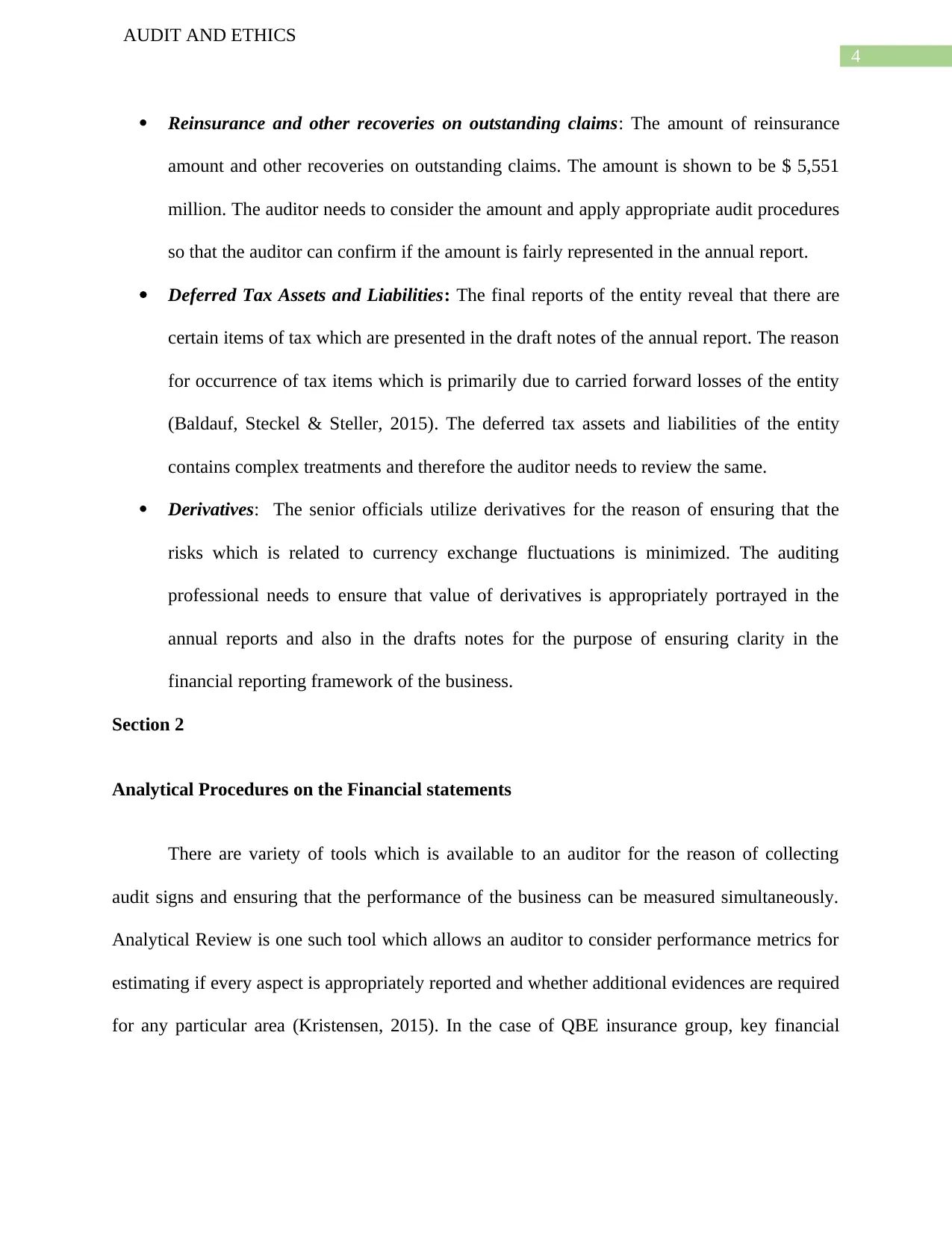
4
AUDIT AND ETHICS
Reinsurance and other recoveries on outstanding claims: The amount of reinsurance
amount and other recoveries on outstanding claims. The amount is shown to be $ 5,551
million. The auditor needs to consider the amount and apply appropriate audit procedures
so that the auditor can confirm if the amount is fairly represented in the annual report.
Deferred Tax Assets and Liabilities: The final reports of the entity reveal that there are
certain items of tax which are presented in the draft notes of the annual report. The reason
for occurrence of tax items which is primarily due to carried forward losses of the entity
(Baldauf, Steckel & Steller, 2015). The deferred tax assets and liabilities of the entity
contains complex treatments and therefore the auditor needs to review the same.
Derivatives: The senior officials utilize derivatives for the reason of ensuring that the
risks which is related to currency exchange fluctuations is minimized. The auditing
professional needs to ensure that value of derivatives is appropriately portrayed in the
annual reports and also in the drafts notes for the purpose of ensuring clarity in the
financial reporting framework of the business.
Section 2
Analytical Procedures on the Financial statements
There are variety of tools which is available to an auditor for the reason of collecting
audit signs and ensuring that the performance of the business can be measured simultaneously.
Analytical Review is one such tool which allows an auditor to consider performance metrics for
estimating if every aspect is appropriately reported and whether additional evidences are required
for any particular area (Kristensen, 2015). In the case of QBE insurance group, key financial
AUDIT AND ETHICS
Reinsurance and other recoveries on outstanding claims: The amount of reinsurance
amount and other recoveries on outstanding claims. The amount is shown to be $ 5,551
million. The auditor needs to consider the amount and apply appropriate audit procedures
so that the auditor can confirm if the amount is fairly represented in the annual report.
Deferred Tax Assets and Liabilities: The final reports of the entity reveal that there are
certain items of tax which are presented in the draft notes of the annual report. The reason
for occurrence of tax items which is primarily due to carried forward losses of the entity
(Baldauf, Steckel & Steller, 2015). The deferred tax assets and liabilities of the entity
contains complex treatments and therefore the auditor needs to review the same.
Derivatives: The senior officials utilize derivatives for the reason of ensuring that the
risks which is related to currency exchange fluctuations is minimized. The auditing
professional needs to ensure that value of derivatives is appropriately portrayed in the
annual reports and also in the drafts notes for the purpose of ensuring clarity in the
financial reporting framework of the business.
Section 2
Analytical Procedures on the Financial statements
There are variety of tools which is available to an auditor for the reason of collecting
audit signs and ensuring that the performance of the business can be measured simultaneously.
Analytical Review is one such tool which allows an auditor to consider performance metrics for
estimating if every aspect is appropriately reported and whether additional evidences are required
for any particular area (Kristensen, 2015). In the case of QBE insurance group, key financial
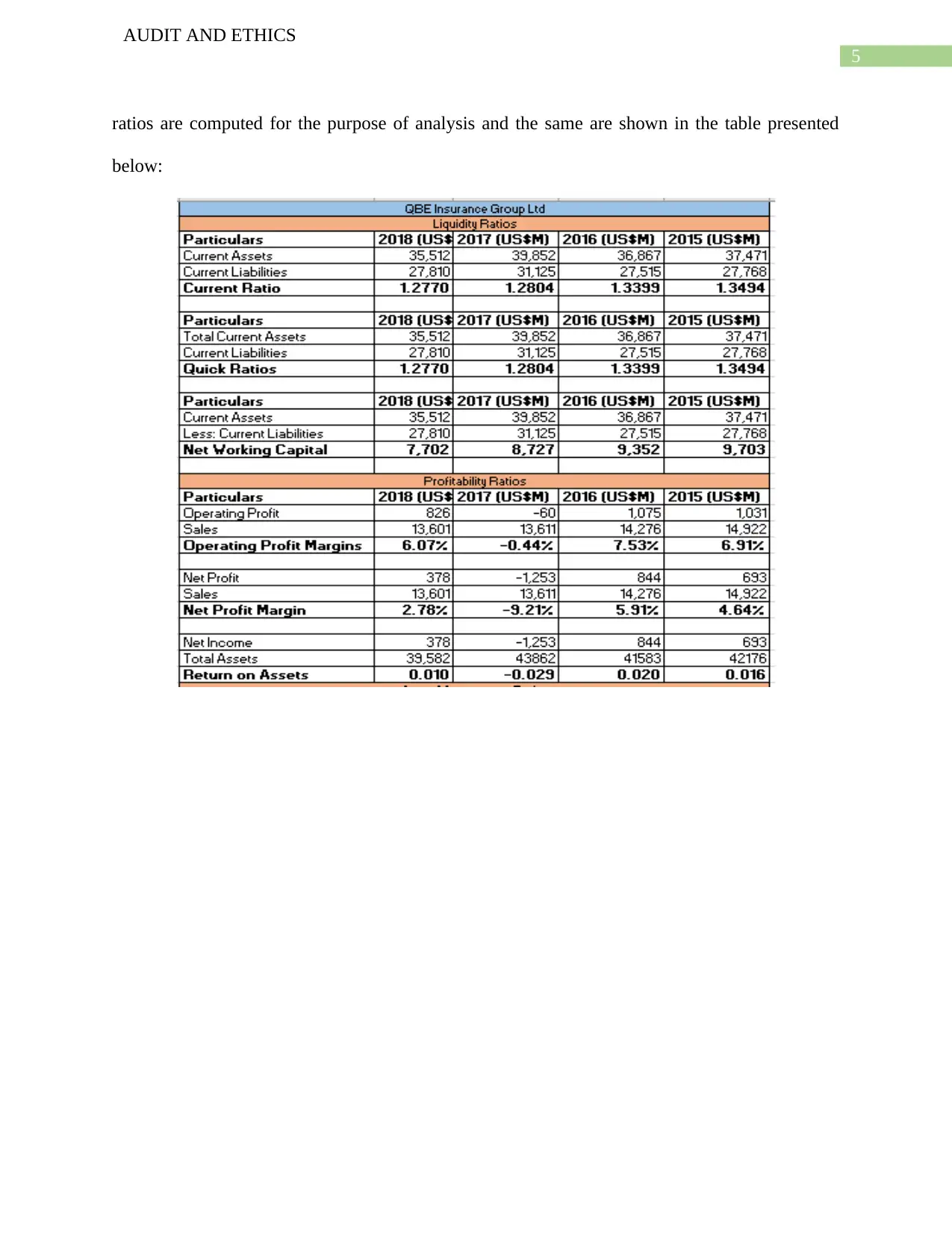
5
AUDIT AND ETHICS
ratios are computed for the purpose of analysis and the same are shown in the table presented
below:
AUDIT AND ETHICS
ratios are computed for the purpose of analysis and the same are shown in the table presented
below:
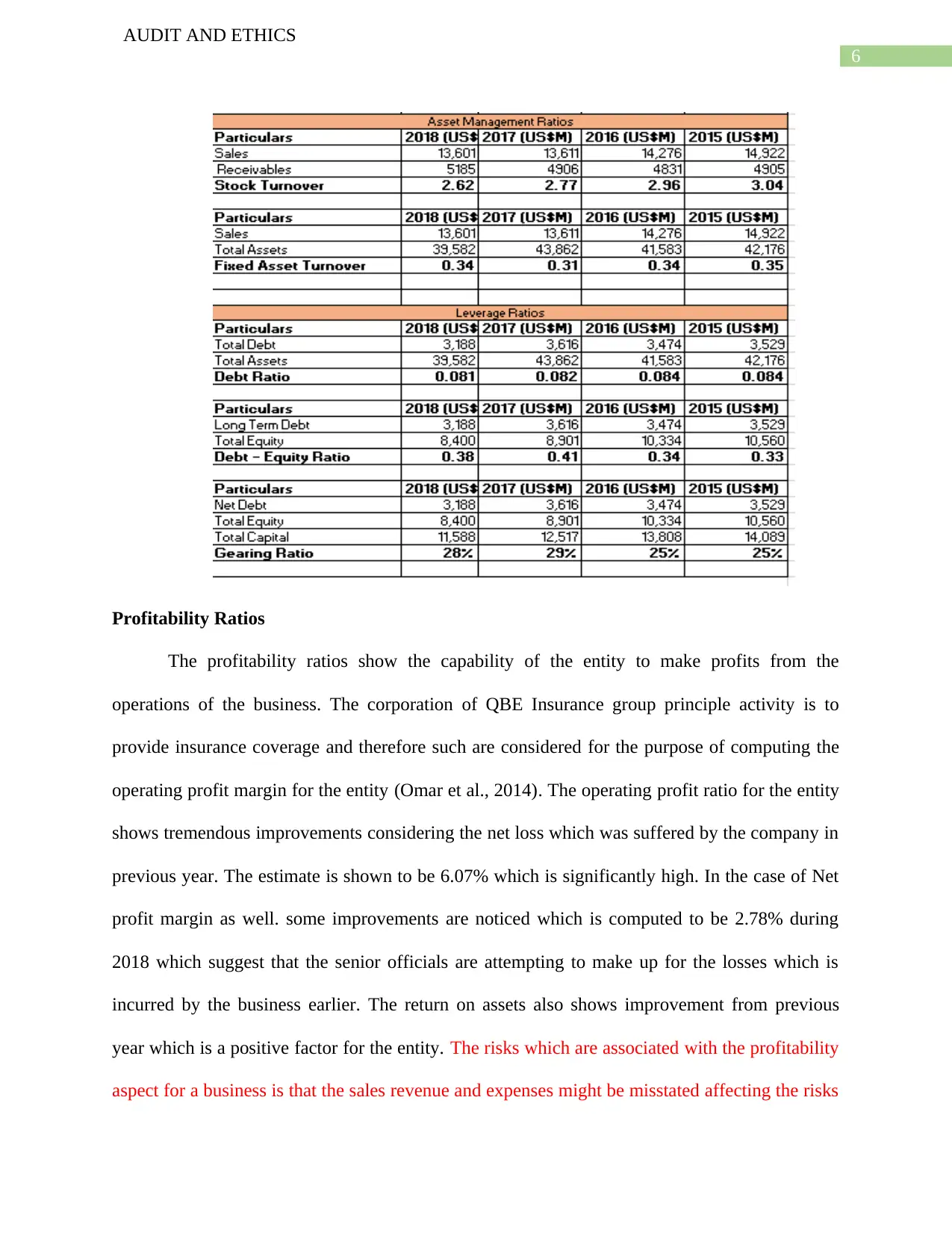
6
AUDIT AND ETHICS
Profitability Ratios
The profitability ratios show the capability of the entity to make profits from the
operations of the business. The corporation of QBE Insurance group principle activity is to
provide insurance coverage and therefore such are considered for the purpose of computing the
operating profit margin for the entity (Omar et al., 2014). The operating profit ratio for the entity
shows tremendous improvements considering the net loss which was suffered by the company in
previous year. The estimate is shown to be 6.07% which is significantly high. In the case of Net
profit margin as well. some improvements are noticed which is computed to be 2.78% during
2018 which suggest that the senior officials are attempting to make up for the losses which is
incurred by the business earlier. The return on assets also shows improvement from previous
year which is a positive factor for the entity. The risks which are associated with the profitability
aspect for a business is that the sales revenue and expenses might be misstated affecting the risks
AUDIT AND ETHICS
Profitability Ratios
The profitability ratios show the capability of the entity to make profits from the
operations of the business. The corporation of QBE Insurance group principle activity is to
provide insurance coverage and therefore such are considered for the purpose of computing the
operating profit margin for the entity (Omar et al., 2014). The operating profit ratio for the entity
shows tremendous improvements considering the net loss which was suffered by the company in
previous year. The estimate is shown to be 6.07% which is significantly high. In the case of Net
profit margin as well. some improvements are noticed which is computed to be 2.78% during
2018 which suggest that the senior officials are attempting to make up for the losses which is
incurred by the business earlier. The return on assets also shows improvement from previous
year which is a positive factor for the entity. The risks which are associated with the profitability
aspect for a business is that the sales revenue and expenses might be misstated affecting the risks
Paraphrase This Document
Need a fresh take? Get an instant paraphrase of this document with our AI Paraphraser
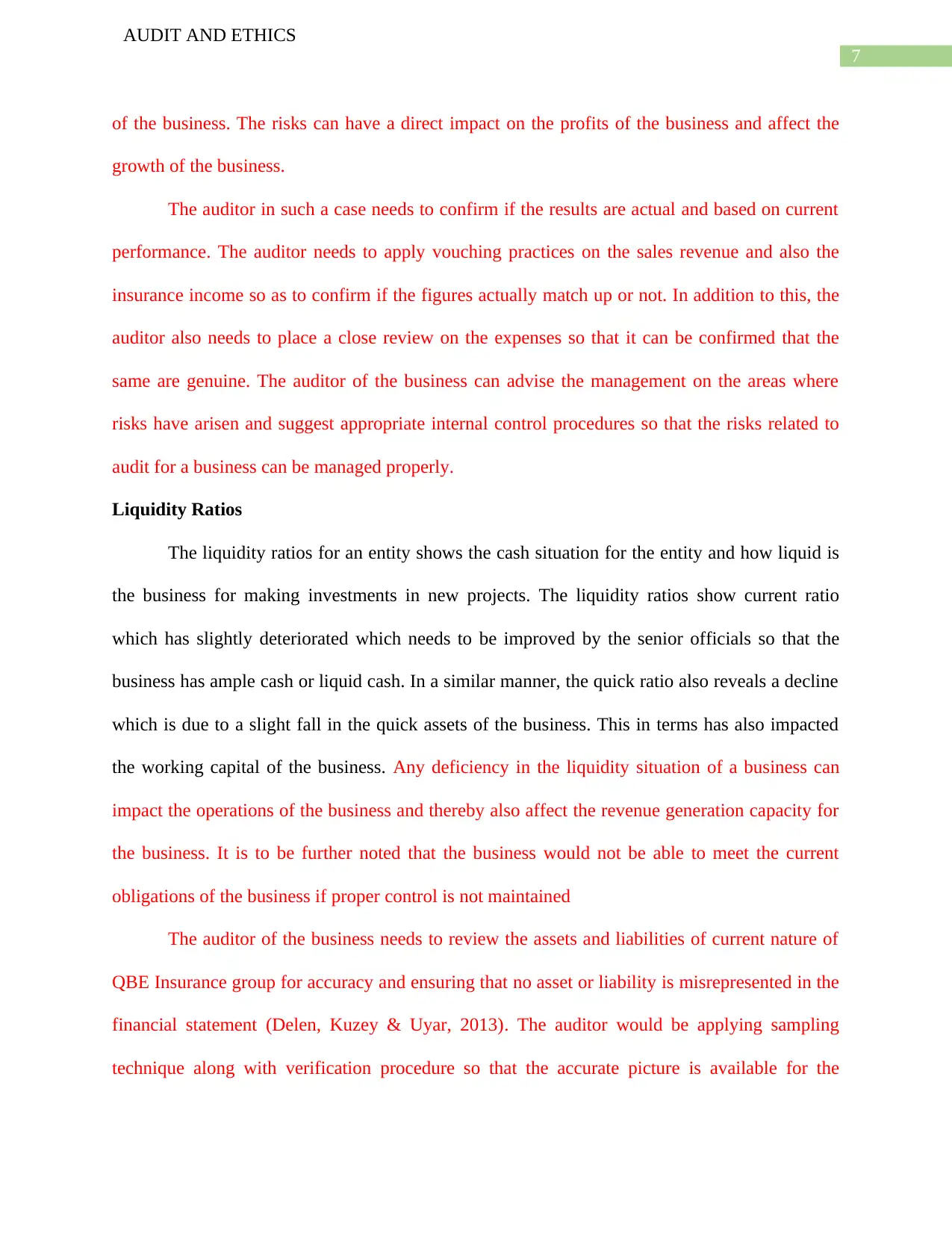
7
AUDIT AND ETHICS
of the business. The risks can have a direct impact on the profits of the business and affect the
growth of the business.
The auditor in such a case needs to confirm if the results are actual and based on current
performance. The auditor needs to apply vouching practices on the sales revenue and also the
insurance income so as to confirm if the figures actually match up or not. In addition to this, the
auditor also needs to place a close review on the expenses so that it can be confirmed that the
same are genuine. The auditor of the business can advise the management on the areas where
risks have arisen and suggest appropriate internal control procedures so that the risks related to
audit for a business can be managed properly.
Liquidity Ratios
The liquidity ratios for an entity shows the cash situation for the entity and how liquid is
the business for making investments in new projects. The liquidity ratios show current ratio
which has slightly deteriorated which needs to be improved by the senior officials so that the
business has ample cash or liquid cash. In a similar manner, the quick ratio also reveals a decline
which is due to a slight fall in the quick assets of the business. This in terms has also impacted
the working capital of the business. Any deficiency in the liquidity situation of a business can
impact the operations of the business and thereby also affect the revenue generation capacity for
the business. It is to be further noted that the business would not be able to meet the current
obligations of the business if proper control is not maintained
The auditor of the business needs to review the assets and liabilities of current nature of
QBE Insurance group for accuracy and ensuring that no asset or liability is misrepresented in the
financial statement (Delen, Kuzey & Uyar, 2013). The auditor would be applying sampling
technique along with verification procedure so that the accurate picture is available for the
AUDIT AND ETHICS
of the business. The risks can have a direct impact on the profits of the business and affect the
growth of the business.
The auditor in such a case needs to confirm if the results are actual and based on current
performance. The auditor needs to apply vouching practices on the sales revenue and also the
insurance income so as to confirm if the figures actually match up or not. In addition to this, the
auditor also needs to place a close review on the expenses so that it can be confirmed that the
same are genuine. The auditor of the business can advise the management on the areas where
risks have arisen and suggest appropriate internal control procedures so that the risks related to
audit for a business can be managed properly.
Liquidity Ratios
The liquidity ratios for an entity shows the cash situation for the entity and how liquid is
the business for making investments in new projects. The liquidity ratios show current ratio
which has slightly deteriorated which needs to be improved by the senior officials so that the
business has ample cash or liquid cash. In a similar manner, the quick ratio also reveals a decline
which is due to a slight fall in the quick assets of the business. This in terms has also impacted
the working capital of the business. Any deficiency in the liquidity situation of a business can
impact the operations of the business and thereby also affect the revenue generation capacity for
the business. It is to be further noted that the business would not be able to meet the current
obligations of the business if proper control is not maintained
The auditor of the business needs to review the assets and liabilities of current nature of
QBE Insurance group for accuracy and ensuring that no asset or liability is misrepresented in the
financial statement (Delen, Kuzey & Uyar, 2013). The auditor would be applying sampling
technique along with verification procedure so that the accurate picture is available for the
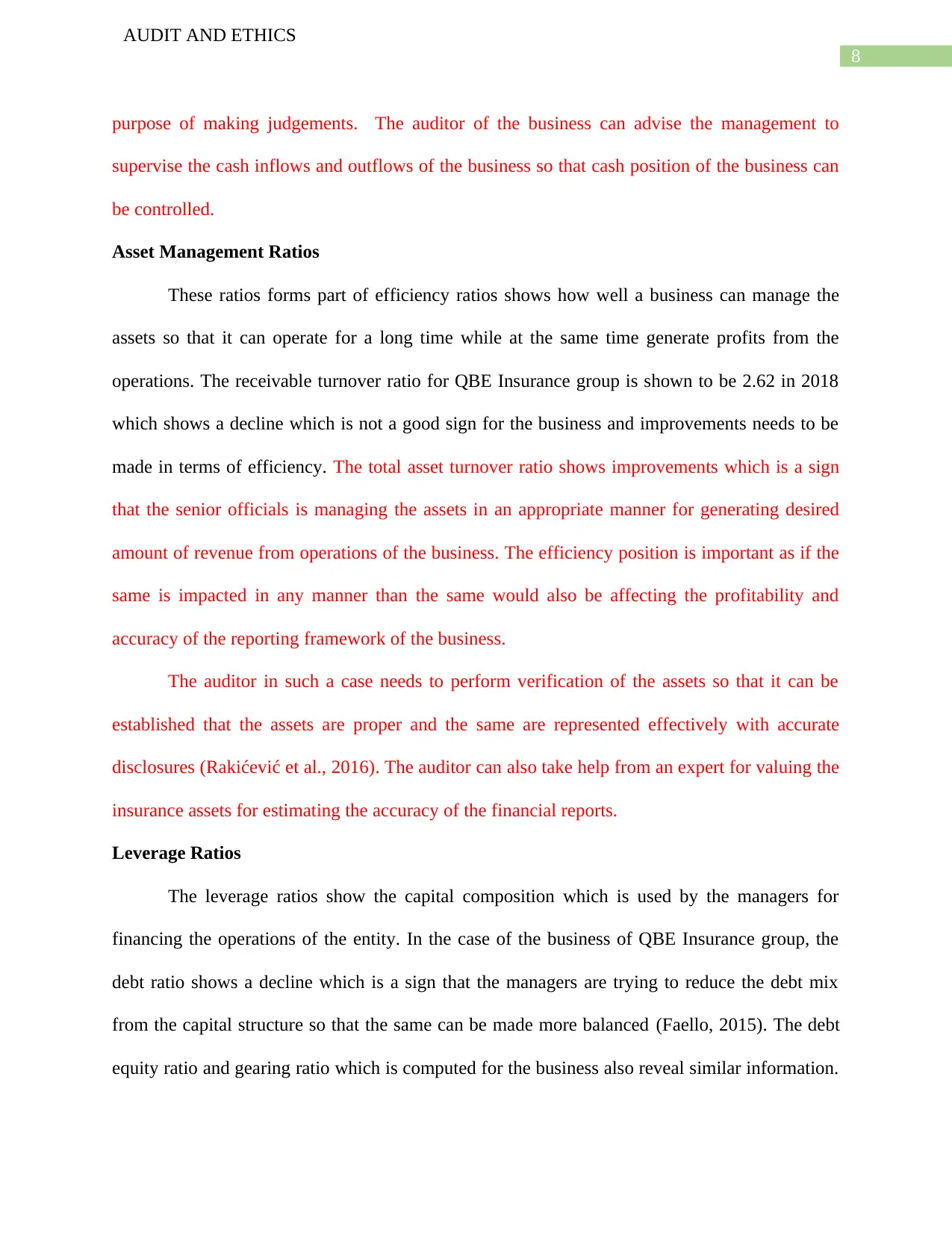
8
AUDIT AND ETHICS
purpose of making judgements. The auditor of the business can advise the management to
supervise the cash inflows and outflows of the business so that cash position of the business can
be controlled.
Asset Management Ratios
These ratios forms part of efficiency ratios shows how well a business can manage the
assets so that it can operate for a long time while at the same time generate profits from the
operations. The receivable turnover ratio for QBE Insurance group is shown to be 2.62 in 2018
which shows a decline which is not a good sign for the business and improvements needs to be
made in terms of efficiency. The total asset turnover ratio shows improvements which is a sign
that the senior officials is managing the assets in an appropriate manner for generating desired
amount of revenue from operations of the business. The efficiency position is important as if the
same is impacted in any manner than the same would also be affecting the profitability and
accuracy of the reporting framework of the business.
The auditor in such a case needs to perform verification of the assets so that it can be
established that the assets are proper and the same are represented effectively with accurate
disclosures (Rakićević et al., 2016). The auditor can also take help from an expert for valuing the
insurance assets for estimating the accuracy of the financial reports.
Leverage Ratios
The leverage ratios show the capital composition which is used by the managers for
financing the operations of the entity. In the case of the business of QBE Insurance group, the
debt ratio shows a decline which is a sign that the managers are trying to reduce the debt mix
from the capital structure so that the same can be made more balanced (Faello, 2015). The debt
equity ratio and gearing ratio which is computed for the business also reveal similar information.
AUDIT AND ETHICS
purpose of making judgements. The auditor of the business can advise the management to
supervise the cash inflows and outflows of the business so that cash position of the business can
be controlled.
Asset Management Ratios
These ratios forms part of efficiency ratios shows how well a business can manage the
assets so that it can operate for a long time while at the same time generate profits from the
operations. The receivable turnover ratio for QBE Insurance group is shown to be 2.62 in 2018
which shows a decline which is not a good sign for the business and improvements needs to be
made in terms of efficiency. The total asset turnover ratio shows improvements which is a sign
that the senior officials is managing the assets in an appropriate manner for generating desired
amount of revenue from operations of the business. The efficiency position is important as if the
same is impacted in any manner than the same would also be affecting the profitability and
accuracy of the reporting framework of the business.
The auditor in such a case needs to perform verification of the assets so that it can be
established that the assets are proper and the same are represented effectively with accurate
disclosures (Rakićević et al., 2016). The auditor can also take help from an expert for valuing the
insurance assets for estimating the accuracy of the financial reports.
Leverage Ratios
The leverage ratios show the capital composition which is used by the managers for
financing the operations of the entity. In the case of the business of QBE Insurance group, the
debt ratio shows a decline which is a sign that the managers are trying to reduce the debt mix
from the capital structure so that the same can be made more balanced (Faello, 2015). The debt
equity ratio and gearing ratio which is computed for the business also reveal similar information.
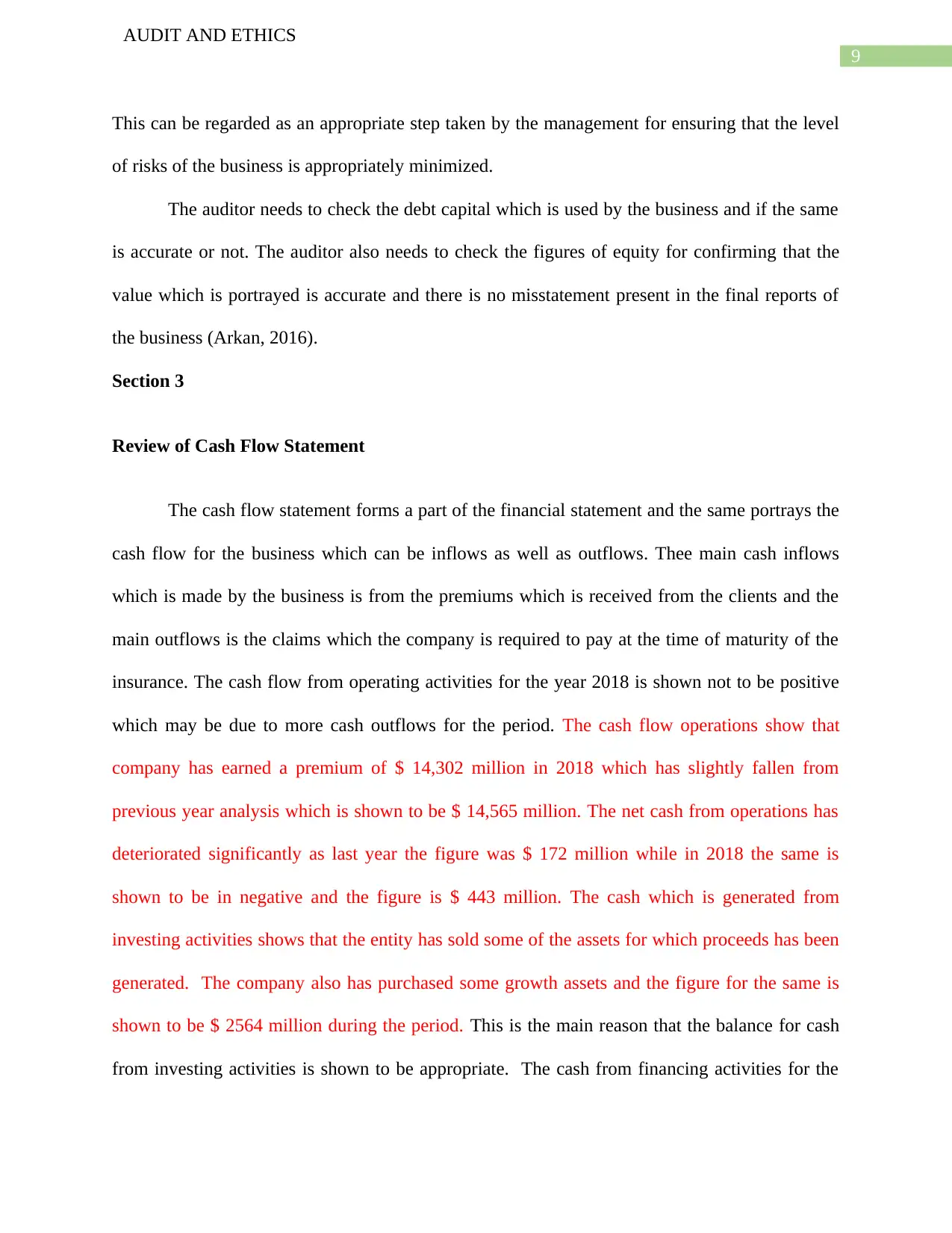
9
AUDIT AND ETHICS
This can be regarded as an appropriate step taken by the management for ensuring that the level
of risks of the business is appropriately minimized.
The auditor needs to check the debt capital which is used by the business and if the same
is accurate or not. The auditor also needs to check the figures of equity for confirming that the
value which is portrayed is accurate and there is no misstatement present in the final reports of
the business (Arkan, 2016).
Section 3
Review of Cash Flow Statement
The cash flow statement forms a part of the financial statement and the same portrays the
cash flow for the business which can be inflows as well as outflows. Thee main cash inflows
which is made by the business is from the premiums which is received from the clients and the
main outflows is the claims which the company is required to pay at the time of maturity of the
insurance. The cash flow from operating activities for the year 2018 is shown not to be positive
which may be due to more cash outflows for the period. The cash flow operations show that
company has earned a premium of $ 14,302 million in 2018 which has slightly fallen from
previous year analysis which is shown to be $ 14,565 million. The net cash from operations has
deteriorated significantly as last year the figure was $ 172 million while in 2018 the same is
shown to be in negative and the figure is $ 443 million. The cash which is generated from
investing activities shows that the entity has sold some of the assets for which proceeds has been
generated. The company also has purchased some growth assets and the figure for the same is
shown to be $ 2564 million during the period. This is the main reason that the balance for cash
from investing activities is shown to be appropriate. The cash from financing activities for the
AUDIT AND ETHICS
This can be regarded as an appropriate step taken by the management for ensuring that the level
of risks of the business is appropriately minimized.
The auditor needs to check the debt capital which is used by the business and if the same
is accurate or not. The auditor also needs to check the figures of equity for confirming that the
value which is portrayed is accurate and there is no misstatement present in the final reports of
the business (Arkan, 2016).
Section 3
Review of Cash Flow Statement
The cash flow statement forms a part of the financial statement and the same portrays the
cash flow for the business which can be inflows as well as outflows. Thee main cash inflows
which is made by the business is from the premiums which is received from the clients and the
main outflows is the claims which the company is required to pay at the time of maturity of the
insurance. The cash flow from operating activities for the year 2018 is shown not to be positive
which may be due to more cash outflows for the period. The cash flow operations show that
company has earned a premium of $ 14,302 million in 2018 which has slightly fallen from
previous year analysis which is shown to be $ 14,565 million. The net cash from operations has
deteriorated significantly as last year the figure was $ 172 million while in 2018 the same is
shown to be in negative and the figure is $ 443 million. The cash which is generated from
investing activities shows that the entity has sold some of the assets for which proceeds has been
generated. The company also has purchased some growth assets and the figure for the same is
shown to be $ 2564 million during the period. This is the main reason that the balance for cash
from investing activities is shown to be appropriate. The cash from financing activities for the
Secure Best Marks with AI Grader
Need help grading? Try our AI Grader for instant feedback on your assignments.
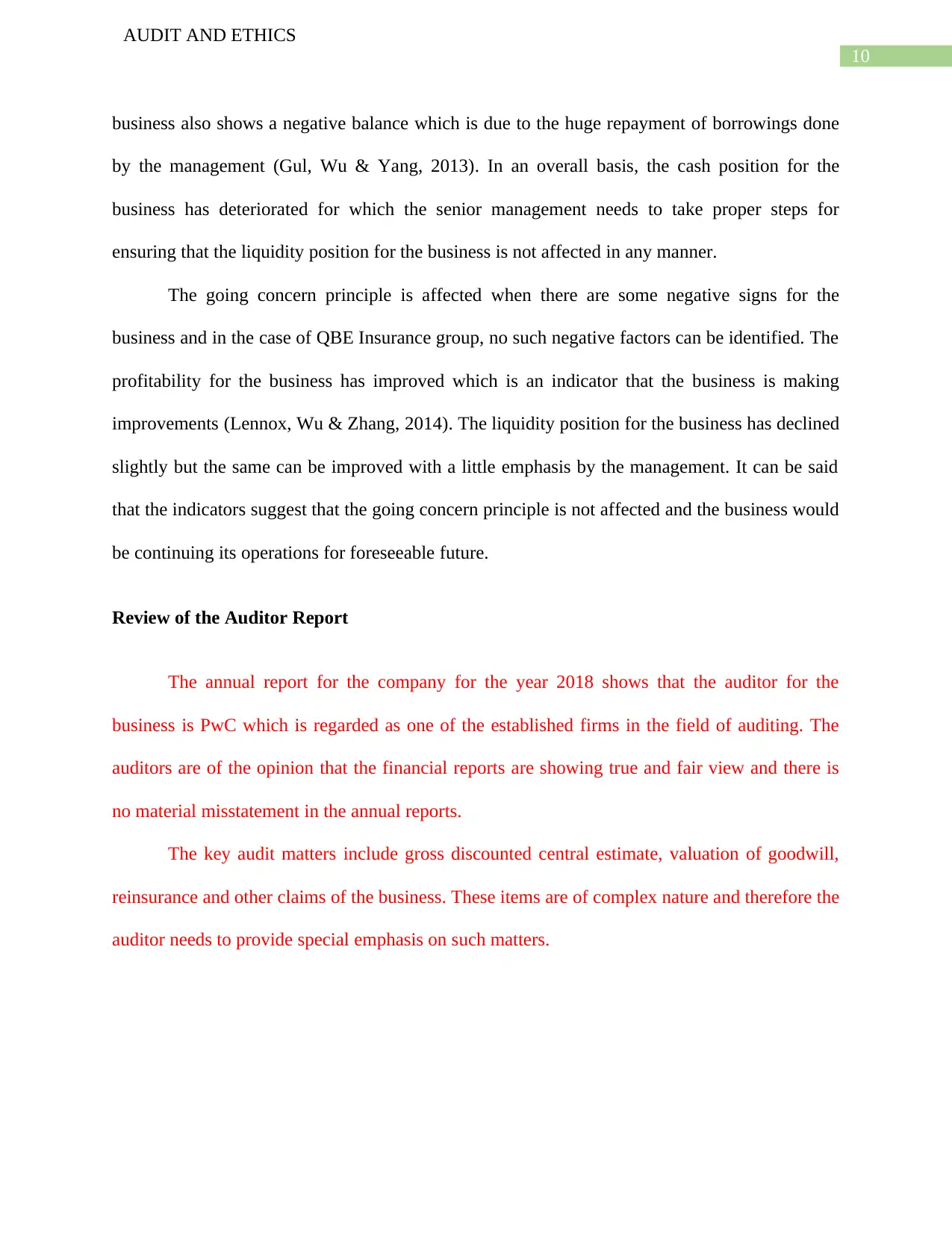
10
AUDIT AND ETHICS
business also shows a negative balance which is due to the huge repayment of borrowings done
by the management (Gul, Wu & Yang, 2013). In an overall basis, the cash position for the
business has deteriorated for which the senior management needs to take proper steps for
ensuring that the liquidity position for the business is not affected in any manner.
The going concern principle is affected when there are some negative signs for the
business and in the case of QBE Insurance group, no such negative factors can be identified. The
profitability for the business has improved which is an indicator that the business is making
improvements (Lennox, Wu & Zhang, 2014). The liquidity position for the business has declined
slightly but the same can be improved with a little emphasis by the management. It can be said
that the indicators suggest that the going concern principle is not affected and the business would
be continuing its operations for foreseeable future.
Review of the Auditor Report
The annual report for the company for the year 2018 shows that the auditor for the
business is PwC which is regarded as one of the established firms in the field of auditing. The
auditors are of the opinion that the financial reports are showing true and fair view and there is
no material misstatement in the annual reports.
The key audit matters include gross discounted central estimate, valuation of goodwill,
reinsurance and other claims of the business. These items are of complex nature and therefore the
auditor needs to provide special emphasis on such matters.
AUDIT AND ETHICS
business also shows a negative balance which is due to the huge repayment of borrowings done
by the management (Gul, Wu & Yang, 2013). In an overall basis, the cash position for the
business has deteriorated for which the senior management needs to take proper steps for
ensuring that the liquidity position for the business is not affected in any manner.
The going concern principle is affected when there are some negative signs for the
business and in the case of QBE Insurance group, no such negative factors can be identified. The
profitability for the business has improved which is an indicator that the business is making
improvements (Lennox, Wu & Zhang, 2014). The liquidity position for the business has declined
slightly but the same can be improved with a little emphasis by the management. It can be said
that the indicators suggest that the going concern principle is not affected and the business would
be continuing its operations for foreseeable future.
Review of the Auditor Report
The annual report for the company for the year 2018 shows that the auditor for the
business is PwC which is regarded as one of the established firms in the field of auditing. The
auditors are of the opinion that the financial reports are showing true and fair view and there is
no material misstatement in the annual reports.
The key audit matters include gross discounted central estimate, valuation of goodwill,
reinsurance and other claims of the business. These items are of complex nature and therefore the
auditor needs to provide special emphasis on such matters.
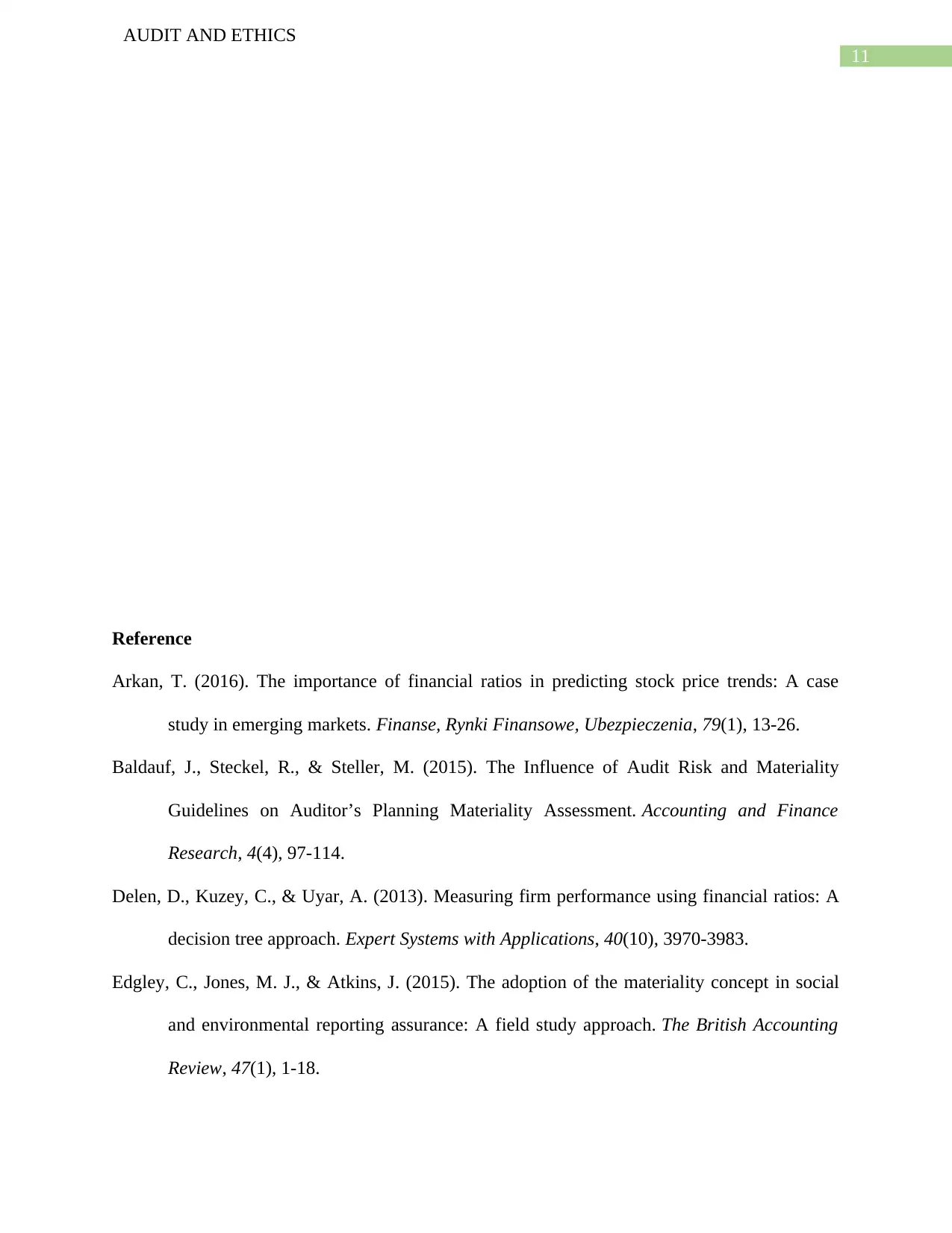
11
AUDIT AND ETHICS
Reference
Arkan, T. (2016). The importance of financial ratios in predicting stock price trends: A case
study in emerging markets. Finanse, Rynki Finansowe, Ubezpieczenia, 79(1), 13-26.
Baldauf, J., Steckel, R., & Steller, M. (2015). The Influence of Audit Risk and Materiality
Guidelines on Auditor’s Planning Materiality Assessment. Accounting and Finance
Research, 4(4), 97-114.
Delen, D., Kuzey, C., & Uyar, A. (2013). Measuring firm performance using financial ratios: A
decision tree approach. Expert Systems with Applications, 40(10), 3970-3983.
Edgley, C., Jones, M. J., & Atkins, J. (2015). The adoption of the materiality concept in social
and environmental reporting assurance: A field study approach. The British Accounting
Review, 47(1), 1-18.
AUDIT AND ETHICS
Reference
Arkan, T. (2016). The importance of financial ratios in predicting stock price trends: A case
study in emerging markets. Finanse, Rynki Finansowe, Ubezpieczenia, 79(1), 13-26.
Baldauf, J., Steckel, R., & Steller, M. (2015). The Influence of Audit Risk and Materiality
Guidelines on Auditor’s Planning Materiality Assessment. Accounting and Finance
Research, 4(4), 97-114.
Delen, D., Kuzey, C., & Uyar, A. (2013). Measuring firm performance using financial ratios: A
decision tree approach. Expert Systems with Applications, 40(10), 3970-3983.
Edgley, C., Jones, M. J., & Atkins, J. (2015). The adoption of the materiality concept in social
and environmental reporting assurance: A field study approach. The British Accounting
Review, 47(1), 1-18.
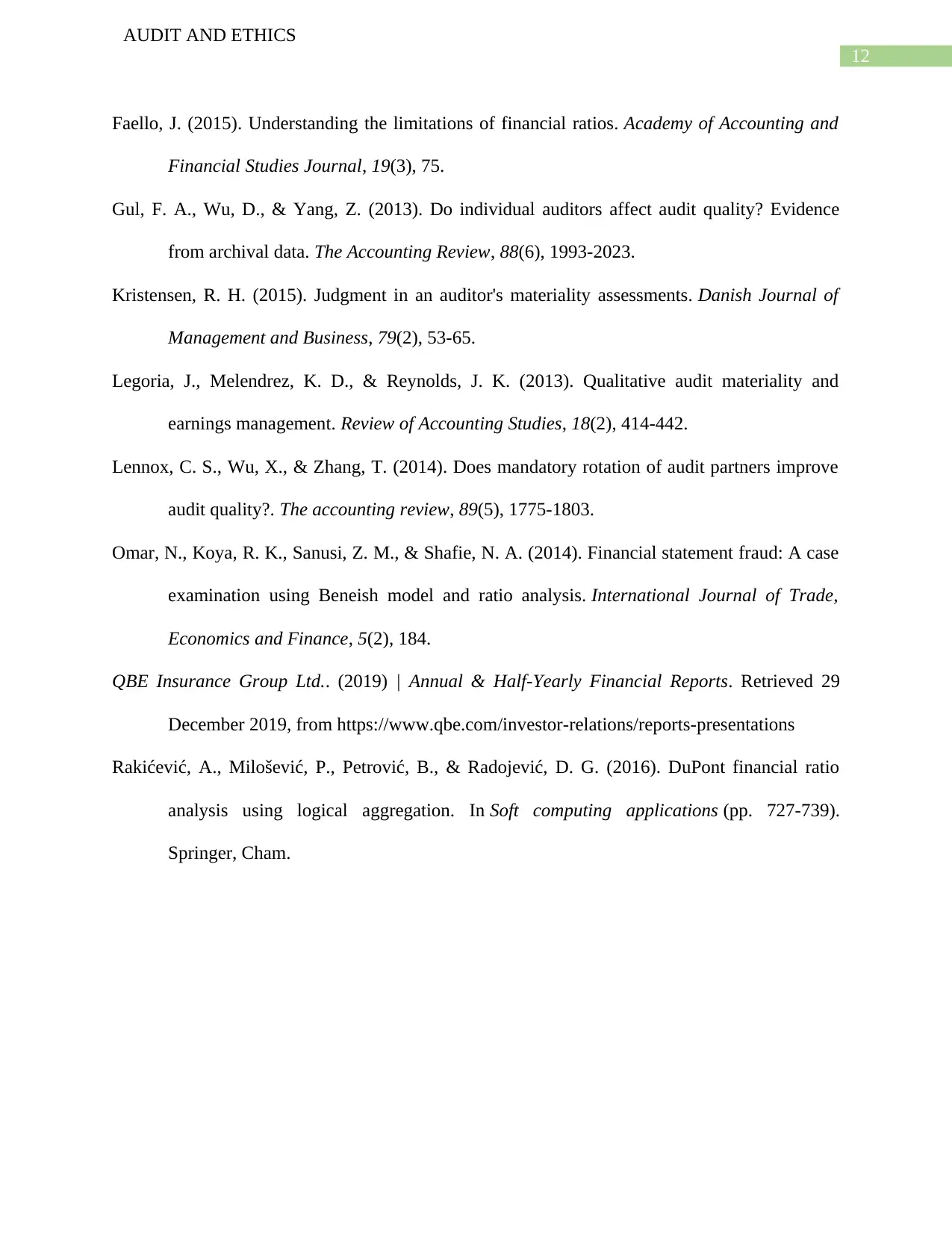
12
AUDIT AND ETHICS
Faello, J. (2015). Understanding the limitations of financial ratios. Academy of Accounting and
Financial Studies Journal, 19(3), 75.
Gul, F. A., Wu, D., & Yang, Z. (2013). Do individual auditors affect audit quality? Evidence
from archival data. The Accounting Review, 88(6), 1993-2023.
Kristensen, R. H. (2015). Judgment in an auditor's materiality assessments. Danish Journal of
Management and Business, 79(2), 53-65.
Legoria, J., Melendrez, K. D., & Reynolds, J. K. (2013). Qualitative audit materiality and
earnings management. Review of Accounting Studies, 18(2), 414-442.
Lennox, C. S., Wu, X., & Zhang, T. (2014). Does mandatory rotation of audit partners improve
audit quality?. The accounting review, 89(5), 1775-1803.
Omar, N., Koya, R. K., Sanusi, Z. M., & Shafie, N. A. (2014). Financial statement fraud: A case
examination using Beneish model and ratio analysis. International Journal of Trade,
Economics and Finance, 5(2), 184.
QBE Insurance Group Ltd.. (2019) | Annual & Half-Yearly Financial Reports. Retrieved 29
December 2019, from https://www.qbe.com/investor-relations/reports-presentations
Rakićević, A., Milošević, P., Petrović, B., & Radojević, D. G. (2016). DuPont financial ratio
analysis using logical aggregation. In Soft computing applications (pp. 727-739).
Springer, Cham.
AUDIT AND ETHICS
Faello, J. (2015). Understanding the limitations of financial ratios. Academy of Accounting and
Financial Studies Journal, 19(3), 75.
Gul, F. A., Wu, D., & Yang, Z. (2013). Do individual auditors affect audit quality? Evidence
from archival data. The Accounting Review, 88(6), 1993-2023.
Kristensen, R. H. (2015). Judgment in an auditor's materiality assessments. Danish Journal of
Management and Business, 79(2), 53-65.
Legoria, J., Melendrez, K. D., & Reynolds, J. K. (2013). Qualitative audit materiality and
earnings management. Review of Accounting Studies, 18(2), 414-442.
Lennox, C. S., Wu, X., & Zhang, T. (2014). Does mandatory rotation of audit partners improve
audit quality?. The accounting review, 89(5), 1775-1803.
Omar, N., Koya, R. K., Sanusi, Z. M., & Shafie, N. A. (2014). Financial statement fraud: A case
examination using Beneish model and ratio analysis. International Journal of Trade,
Economics and Finance, 5(2), 184.
QBE Insurance Group Ltd.. (2019) | Annual & Half-Yearly Financial Reports. Retrieved 29
December 2019, from https://www.qbe.com/investor-relations/reports-presentations
Rakićević, A., Milošević, P., Petrović, B., & Radojević, D. G. (2016). DuPont financial ratio
analysis using logical aggregation. In Soft computing applications (pp. 727-739).
Springer, Cham.
1 out of 13
Related Documents
Your All-in-One AI-Powered Toolkit for Academic Success.
+13062052269
info@desklib.com
Available 24*7 on WhatsApp / Email
![[object Object]](/_next/static/media/star-bottom.7253800d.svg)
Unlock your academic potential
© 2024 | Zucol Services PVT LTD | All rights reserved.





